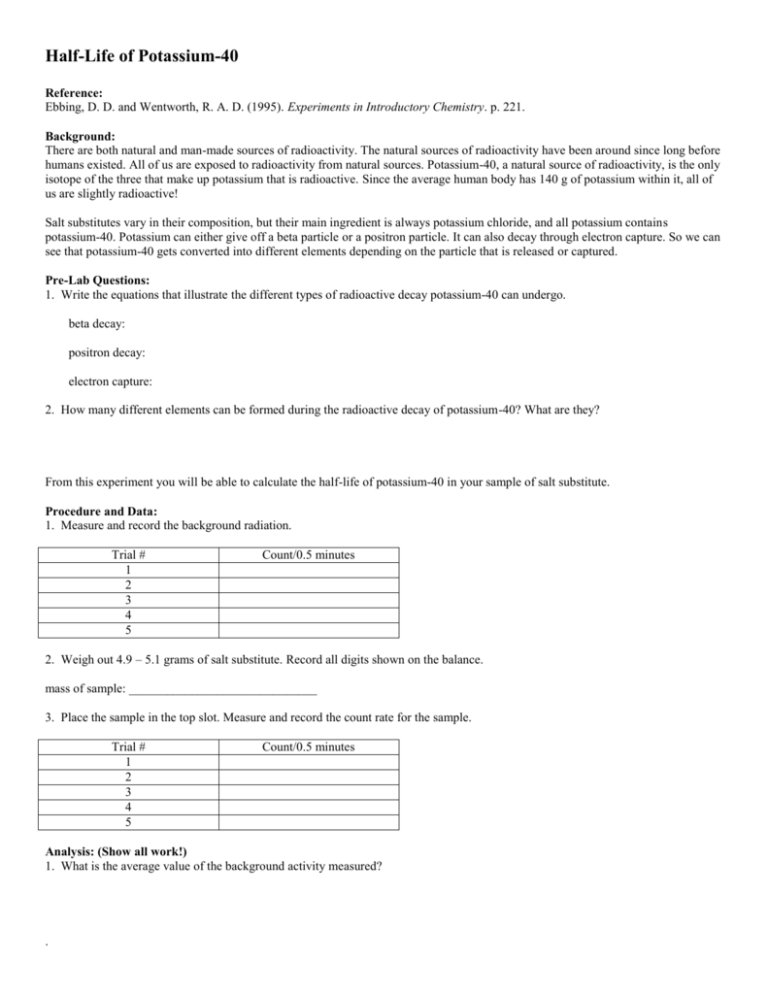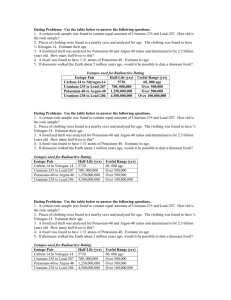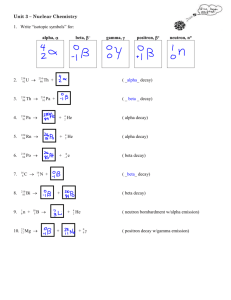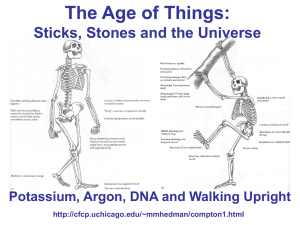Half-Life of Potassium-40
advertisement

Half-Life of Potassium-40 Reference: Ebbing, D. D. and Wentworth, R. A. D. (1995). Experiments in Introductory Chemistry. p. 221. Background: There are both natural and man-made sources of radioactivity. The natural sources of radioactivity have been around since long before humans existed. All of us are exposed to radioactivity from natural sources. Potassium-40, a natural source of radioactivity, is the only isotope of the three that make up potassium that is radioactive. Since the average human body has 140 g of potassium within it, all of us are slightly radioactive! Salt substitutes vary in their composition, but their main ingredient is always potassium chloride, and all potassium contains potassium-40. Potassium can either give off a beta particle or a positron particle. It can also decay through electron capture. So we can see that potassium-40 gets converted into different elements depending on the particle that is released or captured. Pre-Lab Questions: 1. Write the equations that illustrate the different types of radioactive decay potassium-40 can undergo. beta decay: positron decay: electron capture: 2. How many different elements can be formed during the radioactive decay of potassium-40? What are they? From this experiment you will be able to calculate the half-life of potassium-40 in your sample of salt substitute. Procedure and Data: 1. Measure and record the background radiation. Trial # 1 2 3 4 5 Count/0.5 minutes 2. Weigh out 4.9 – 5.1 grams of salt substitute. Record all digits shown on the balance. mass of sample: ______________________________ 3. Place the sample in the top slot. Measure and record the count rate for the sample. Trial # 1 2 3 4 5 Count/0.5 minutes Analysis: (Show all work!) 1. What is the average value of the background activity measured? . 2. What is the average value of the total (background and sample) activity measured: 3. What is the average value of the sample activity alone? 4. How many potassium nuclei are in your sample? (Assume your sample consists only of potassium chloride, KCl.) 5. There is only 0.012% of the potassium-40 isotope in any sample of potassium. Using this information the answer above, how many potassium-40 nuclei are in your sample? 6. Calculate the half-life of potassium-40 in your sample using the following equation: 0.693 t1 Nt 2 rate where t 1 is the half-life of potassium-40, rate is the average value of the sample activity x 5 (multiply by 5 because your counter will 2 only detect about 1/5 of the emitted radiation), and N t is the number of potassium-40 nuclei in your sample. Be sure to express t 12 in units of years. 7. It is important to note that the half-life is different for each decay processes. The beta decay/electron capture process occurs about 10 times faster than the positron decay process. The half-life of potassium-40 that decays through beta emission is 1.28 × 10 9 years, however the half-life of potassium-40 that decays through positron emission is 1.19 × 1010 years. Using this information, how do you think your potassium-40 decayed? Explain. 8. Name three foods that you eat regularly that contain potassium? How much potassium do they contain? .









